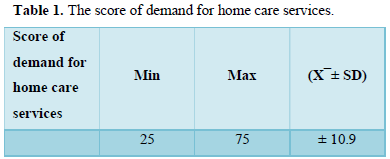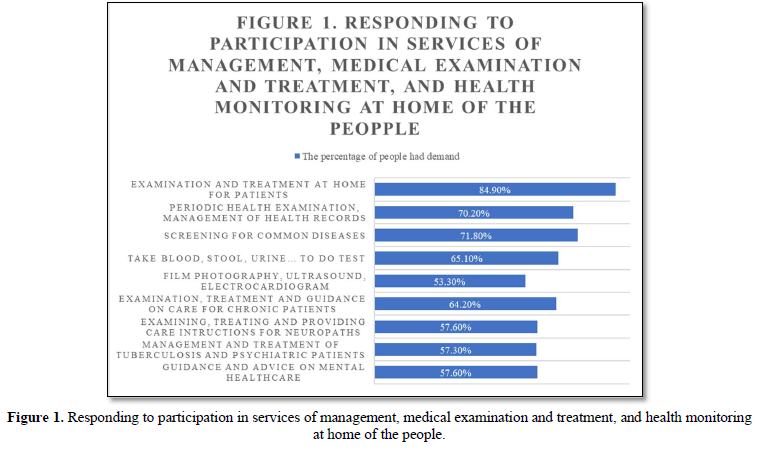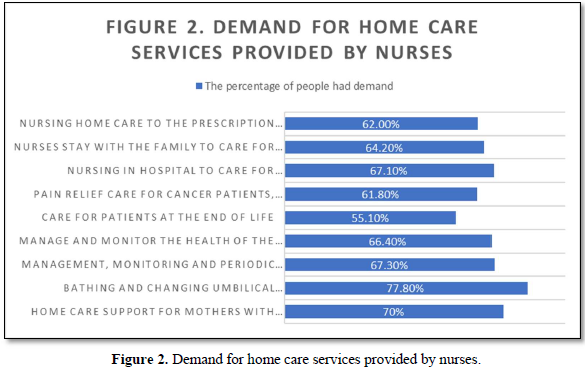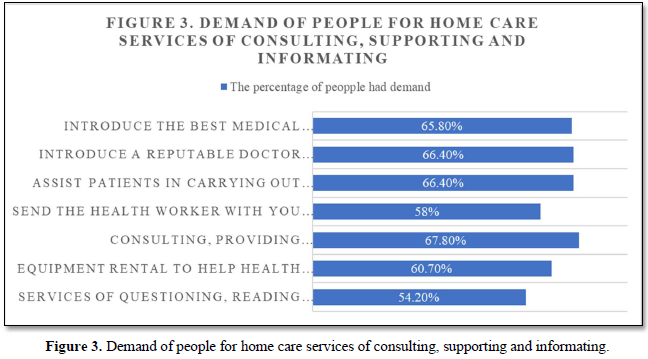Research Article
Demand for Home Care Services and Planning to Meet the Demand for Home Care Services of People in Ha Long, Quang Ninh in 2020
4015
Views & Citations3015
Likes & Shares
Objective: To describe the demand for home care services of people in Ha Long- Quang Ninh, in order to develop a plan to train medical personnel to meet home care demand of people in Ha Long, Quang Ninh.
Method: A cross- sectional descriptive study was conducted to collect data from 450 participants representing 450 households from 5 wards in Ha Long City. The data was collected using questionnaire to interview.
Results: The research results show the most demand for home care services are examination and treatment at home (84.9%), screening for common diseases (71.8%), bathing and changing umbilical bandage at home for infants (64.2%), home care support for mothers with children under 6 months (62.0%). In addition, some services with a low rate of demand from people such as: film photography, ultrasound, electrocardiogram (53.3%), care for patients at the end of life (55.1%), questioning, reading films, reading test results, exploring function (54.2%), consulting from a distance through Internet and camera (60.0%).
Quang Ninh Medical college had sent to train 6 lecturers to teach theory, 6 lecturers to teach clinical practice, developed and completed 05 training programs and training materials, and prepared a system of practical facilities to meet training needs for 05 health workers who are doctors, medics, nurses, midwives and pharmacy staff working at commune health stations to take care of their health at home according to family medicine principles in Ha Long city and Quang Ninh province.
Conclusion: The people in Ha Long City has a high demand for home care services, so that it is very necessary to train medical personnel providing home care services for people.
Keywords: Demand, Home care, Services
INTRODUCTION
Similar to developed countries in the previous period, since 2012, Viet Nam has become a country with aging population, with the rate of people over 60 reaching 10.2% and is forecasted to be a country with very old population by 2038, the rate of people over 60 will reach 20.1% [1]. This is the reason for challenging in caring to improve the health of population when the need for daily healthcare is becoming a major problem: burden of disease, daily care, raising the quality of life. In addition, overload of hospital is still an issue that needs to be resolved sustainably [2]. Many diseases, injuries, and accidents can be treated at home and still be effective, save costs and reduce the risk of hospital infection for patients. It is also considered to be more effective than hospital care [3]. However, home care services with the incorporation of advanced technology are capable of solving these problems, bringing positive results in treatment and improvement of people’s health [4]. Ha Long City has the highest population in Quang Ninh province, the economic status of people here is higher than the province’s average. Therefore, they have high demand for healthcare activities, especially home care. With the mentioned benefits, home care services are able to meet the need of people here about medical care. However, home care is Ha Long is still relatively spontaneous, not systematically organized. For that reason, the study was conducted with the aim: To describe the demand for home care services of people in Ha Long- Quang Ninh, in order to develop a plan to train medical personnel to meet home care demand of people in Ha Long, Quang Ninh.
RESEARCH METHOD
Research subjects: Representatives of family residences in Ha Long City can take part in the selection or decision to use home care services.
Setting and research period
- The study was conducted from September 2019 to December 2020.
- Setting: Residences in 20 wards of Ha Long City, Quang Ninh.
- Research design: Cross-section description.
- Sample size:
- Apply the sample size formula:

Inside:
- n: Sample size required
- p: Percentage of people have demand for home care. Take p= 0.5.
Then 1-p= 0.5.
- d: Allowable deviation between the rate obtained from the sample and the proportion of the population. Take d= 0.05.
- α: Significant level. Take α= 0.05.
- Value obtained from table Z corresponding to each selected α value.
α= 0.05, =1.96
- n= 384.
Expected 20% of the subjects are absent or refuse to participate in the study. So, the sample size of the study is: 384+384x20%= 450.
Sampling method: Apply cluster sampling method.
- Make a list of 20 wards of Ha Long City.
- Randomly choose 5 wards to study (Cao Thang, Cao Xanh, Hong Hai, Ha Tu, Bai Chay). Each ward selects 90 households.
- Make a list of the 5 selected wards. 90 chosen households are divided equally among the areas in the wards. One person will represent one household.
Data collection and research instruments: All data were collected using questionnaire to interview subjects.
The instruments consisted of 3 parts:
- Part A: General information questionnaire: Included 8 questions of age, gender, occupation, education level, health insurance, family members.
- Part B: The questionnaire of people’s perception: Included 14 questions about disease patterns, population and health on a 3-point rating scale, where 1= agree, 2= disagree, 3= don’t know. The total score ranged from 14 to 52 which were summed from all items’ score.
- Part C: The questionnaire of demand for home care demand: Included 25 questions. The participants were asked to consider and rate the demand for home care demand for home care services with each item on a 3-point scale from 1 to 3: 1= participation and willing to pay when needed, 2= not participating, 3= undecided. The total score ranged from 25 to 75 points.
Data analysis: Data were entered using Epi Data 3.1 software. The data were synthesized by using SPSS 16.0 software.
RESULTS
Demand for home care services of people
Table 1 showed that the average score of demand for home care services was 63.5 ± 10.9. The lowest score was 25 points, the highest was 75 points.


Demand of people for services of examining, treating and health monitoring at home
The Figure 1. Indicated that the demand for home care services of people was quite high: examination and treatment at home for the patients (84.90%), periodic health examination management of health records (70.20%), screening for common diseases (71.80%). Other services were responded by people at an average or low level.

The Figure 1. Indicated that the demand for home care services of people was quite high: examination and treatment at home for the patients (84.90%), periodic health examination management of health records (70.20%), screening for common diseases (71.80%). Other services were responded by people at an average or low level.

Demand for home care services provided by nurses
The Figure 2 showed that more than two-third of subjects had demand for home care services provided by nurses such as: bathing and changing umbilical bandage at home for infants (77.8%), home care support for mothers with children under 6 months (70%), management, monitoring and periodic health checks for pregnant women (67.3%). Other services were responded by the people on average (over 60%). End-of-life patient care services had the lowest response rate (55.1%).

Demand of people for home care services of consulting, supporting and informating
The Figure 3 Indicated that the demand of people for home care services of counseling, supporting and informating in medical examination and treatment was below 70% such as: Consulting, providing information channels for drugs and functional foods (67.8%), introducing a reputable doctor suitable for examination and treatment of patients (66.4%). The services with the lowest response were services of questioning, reading films, reading test results, exploring function, consulting from a distance.

Developing a plan to train medical personnel to meet home care demand of people in Ha Long, Quang Ninh
Quang Ninh Medical College is a school that trains high-quality medical staff to serve the medical needs of people inside and outside the province. To meet the demand for home care services, Quang Ninh Medical college had sent to train 6 lecturers to teach theory, 6 lecturers to teach clinical practice, developed and completed 05 training programs and training materials, and prepared a system of practical facilities to meet training needs for 05 health workers who are doctors, medics, nurses, midwives and pharmacy staff working at commune health stations to take care of their health at home according to family medicine principles in Ha Long city and Quang Ninh province.
DISCUSSION
Demand of people for services of examining, treating and health monitoring at home
Demand of people for services of examining, treating and health monitoring by doctors at home for emergency patients had the highest rate. The findings of our study are higher than the collected data from people in urban areas at Me Tri ward, Nam Tu Liem, Hanoi by Do Manh Hung in 2018 (57.9%) [5]. This is because in Hanoi, this service is no longer new to people, when private health services have provided them very early. Meanwhile, in Ha Long, there is hardly any private clinic providing this service. Activities related to periodic examinations and screening for early common diseases were also concerned. People take the initiative in monitoring their health more, not until the symptoms appeared would they go to doctors as before. Instead, they want to be managed, monitored, examined periodically, screened to detect dangerous diseases early. Taking blood, stool, urine… to do test at home was also responded with a fairly high rate (65.1%). Compared to the study in Tay Ho District in Hanoi where 83.2% of people have used ultrasound, taking sample test at home, our study shows a much lower response [6]. The reason is that all the subjects of the study in Tay Ho were the elderly or the guardians of the elderly, so they’re going to health facilities to take diagnostic tests is relatively difficult. Moreover, home scan, electrocardiography or ultrasound are often performed by technicians, these paraclinical tests require review, reading results as well as consultation of doctors. Therefore, when these services are implemented in the community, it is necessary to attach the coverage of the doctor when reading test results and consulting the direction of management, to meet the needs of the people using these services.
The service of organizing, sending doctors to examine, treat, provide care instructions to chronic patients is also quite high in response (64.2%), similar to the results in the study of Do Manh Hung (62.6%) [5].
Demand for home care services provided by nurses
Among the home care services provided by nurses, bathing and changing the umbilical bandage at home for infants was responded by the people of Ha Long city with the highest rate (77.8%). The result of our research is equivalent to the study of Do Manh Hung (78.5%) [5]. This is one of the services that needs to be provided in home care services, requiring home care centers to train nurses and midwives well to meet the high demand of people. For other services such as nursing home care to the prescription of doctors, pain relief care for cancer patients, end-stage HIV compared to Do Manh Hung’s research, the response rate in our study is lower. In addition, the services of managing and monitoring the health of the elderly, nurses stay with family to care for critically ill patients, hospital nursing for patients as substitution for their family members compared to the study of Do Manh Hung is higher [5]. This can be explained because in our research, more than two-thirds of the study subjects aged 40 and over, the age group that can experience many health problems related to chronic diseases, but in Do Manh Hung’s study the opposite occurred, more than 2/3 of the study subjects are under 40 years old [5].
Demand of people for home care services of consulting, supporting and informating
Among demand of people for home care services of consulting, supporting and informating, consulting, providing information channels for drugs and functional foods had the highest rate (67.8%). In the era of information explosion, the lack of basic information for health care will lead to the incorrect choice of drugs or functional foods, causing a lot of economic and health damage. The consultation on choosing the right and quality drugs and functional foods to treat diseases and improve health, despite not being direct health care activities, has a significant impact on people’s health. So that, it is feasible to implement these services. Services of questioning, reading films, reading test results, exploring functions, consulting from a distance had the lowest response rate (54.2%). Other studies have also shown that the response to this service is also quite low [5]. Although telemedicine can help people access to specialist doctors, at the same time saving travel and accommodation cost, the service is quite new in Viet Nam, there are many reasons why people are hesitant when deciding to participate in this service.
Human resource training to meet the needs of home health care
Implementing the project "Building and developing the grassroots health network in a new situation" of the Ministry of Health, there have been 15 medical colleges across the country participating in training health workers in caregiving primary health according to the principles of family medicine. Quang Ninh Medical College has actively trained lecturers, developed programs, textbooks, and prepared practical rooms for continuing training in primary health care according to medical principles of family medicine for grassroots health workers of Ha Long City and Quang Ninh Province. At the same time, establishing family doctor clinics to meet the needs of home care for people in Ha Long City - Quang Ninh.
CONCLUSION
Some home care services are highly demanded such as: examination and treatment at home for patients (84.9%), bathing and changing the umbilical bandage at home for infants (77.8%), home care support for mothers with children under 6 months (70%). Some home care services are low demand such as: Film photography, ultrasound, electrocardiogram (53.3%), care for patients at the end of life (55.1%), services of questioning, reading film, reading test results, exploring functions, consulting from a distance (54.2%).
RECOMMENDATION
The health care providers in Ha Long city and Quang Ninh province should have a plan to prepare a team of family doctors, community nurses, caregivers with appropriate expertise and practical skills to be ready for home care services. A further study with large scale should be conducted in different areas to examine the demand of home care services of people in Viet Nam, then the model can be deployed synchronously throughout of the country.
- General statistic organization (2016) Population forecast for Viet Nam 2014 - 2049. GSO: News Publishing House, Hanoi.
- Health Strategy and Policy Institute (2011) The situation and solutions for the overload and underload of the level of the hospital system. Available online at: http://www.hspi.org.vn/vcl/Nghiencuu-thuc-trang-qua-tai-duoi-tai-cua--hethong-benh-vien-cac-tuyen-va-de-xuatgiai--phap-khac-phuc-t85-8128.html
- Lesley L, Shirlee S, Barb M (2003) An Overview of Home Care in Canada: Its Past, Present, and Potential. Home Health Care Management & Practice. Available online at: http://journals.sagepub.com/doi/abs/10.1177/1084822303252401
- Policy and Consultation Branch Health Canada the Office of Health and the Information Highway (1998). Tele-homecare: An Overview. Background Paper for Discussion.
- Do MH (2018) Factors related to Demand and response to home health care services in urban areas Me Tri Ward, Nam Tu Liem District, Hanoi city, 2018. Hanoi Medical Uni J.
- Tac PV, Hieu DT, Thu N, Thi H (2016) Home health care needs of elderly people in Tay Ho district, Hanoi, 2016 and related factors. J Pract Med 7(1015): 23.
QUICK LINKS
- SUBMIT MANUSCRIPT
- RECOMMEND THE JOURNAL
-
SUBSCRIBE FOR ALERTS
RELATED JOURNALS
- Journal of Blood Transfusions and Diseases (ISSN:2641-4023)
- Journal of Infectious Diseases and Research (ISSN: 2688-6537)
- Journal of Rheumatology Research (ISSN:2641-6999)
- Journal of Allergy Research (ISSN:2642-326X)
- Journal of Oral Health and Dentistry (ISSN: 2638-499X)
- Journal of Pathology and Toxicology Research
- Archive of Obstetrics Gynecology and Reproductive Medicine (ISSN:2640-2297)





